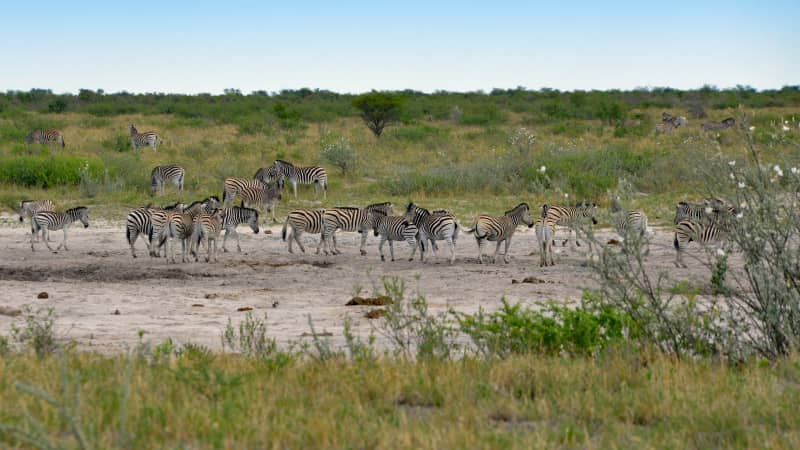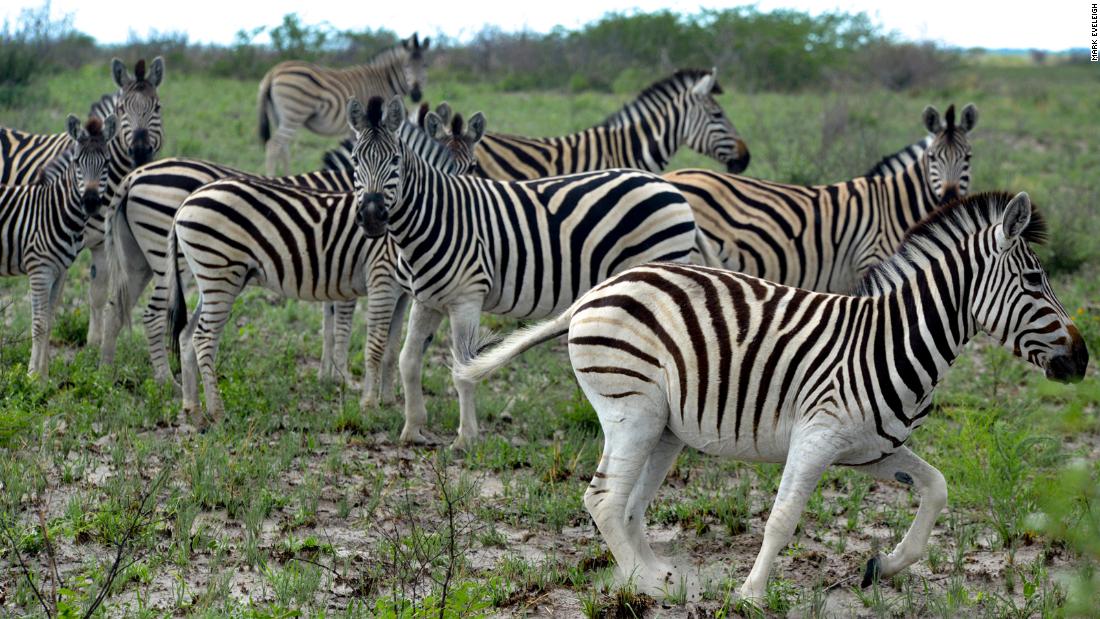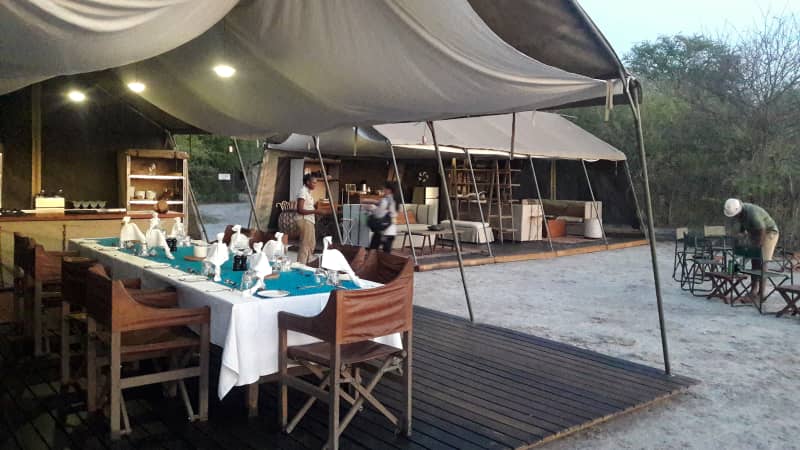(CNN) — The chopper rose smoothly from Maun Airport and we hurtled ahead over Thamalakane River. I knew it was a ‘river’ only because I could see a bridge — there was nothing about the sandy ribbon of dust to suggest it had ever been touched by water.
It was hard to imagine that, just 30 kilometers (18.6 miles) away, the world’s largest inland delta sprawled northwards, stretching beyond Namibia’s Caprivi Strip border.
This is Botswana’s Nxai Pan National Park — part of our planet’s biggest expanse of salt pans. It’s an isolated region where the 600 square kilometers of Okavango Delta finally seeps away into the insatiable sands of the Kalahari Desert — aptly known to early travelers as “the great thirstland.”
It’s so remote that the thing I was here to see, the world’s longest annual mammal migration, which sees 20,000 zebras cross these pans, wasn’t even documented until a decade ago.
I’d explored the Kalahari twice in the past by Land Rover and had also traveled in the Okavango several times. I’d sat around Kalahari campfires under a dome of stars that seemed to rest directly on the horizon and I’d driven among lions in Deception Valley, where mirages are so realistic they’re said to lure migrating pelicans to their deaths.
I’d always been stunned by Botswana’s mind-boggling geographical contrast of desert and delta, but the diversity was often hard to appreciate because (apart from the relatively low-lying Tsodilo Hills) the country is almost entirely flat. But the flight in the chopper — hovering just a couple of hundred meters over the ground — offered a privileged overview of the desert landscape.
“Looks pretty dry and dusty from up here, right?” the pilot’s voice crackled through my earphones. “You’d be surprised how it can green up with even just the shortest splash of rain.”
Botswana skyscrapers

Each year, thousands of zebras make a 500-kilometer trek across a remote region of Botswana.
Mark Eveleigh
Joe Healy was a long way from the boggy greenery of his native Ireland but, after 2,000 hours of flying time, Botswana held few secrets for him. He’d clearly honed a practiced eye for airborne safaris too. Suddenly he cranked the joystick over to the right and we banked steeply: “There look. Botswana skyscrapers!”
A herd of giraffes threw lanky shadows over the thorn-scrub as they browsed among a stand of acacias.
“Have you seen any big zebra herds lately?” I asked.
Not many safari-goers tend to consider the humble zebra a prime wildlife sighting. Healy was well aware that, like most visitors who head to Nxai Pan this time of year, I was hoping to witness one of the most astounding wildlife spectacles on the African continent.
With the coming of the rains, an estimated 20,000 Burchell’s zebras (Equus quagga) would converge on Nxai Pans during what has only recently been recognized as the longest mammal migration in Africa.
But — even from his lofty vantagepoint — Healy was yet to see the first dust-clouds that would herald the stomping of 80,000 hooves.
Up ahead we could see the bone-white glint of the salt pans in Nxai Pan National Park. It was only in 2012 that astounded researchers in the park realized that some zebras were covering more than 1,000 kilometers (620 miles) during their three-month return trek. This was substantially farther than the migration of wildebeests and zebras during their well-known seasonal journey through the Serengeti ecosystem.
“The distance covered by the zebra was a total shock to all of us involved,” Robin Naidoo, a senior conservation scientist at World Wildlife Fund, said at the time. “Nobody knew that something of this scale was occurring.”
As Healy eased the chopper down onto the cracked earth beside the boundary of Nxai Pan National Park I noted again that there was precious little greenery to attract grazing animals.
“It’s been a very long dry season,” African Bush Camps guide Kenneth Mungomba told us as we set off into the park in an open game-driving vehicle.
Untamed Africa
It had been a particularly tough time for the elephants I realized. We held our noses as we drove past a pachyderm carcass, scattering jackals and a loping hyena. We were over a thousand kilometers from the ocean but the giant carcass, lying in the lee of a small sand dune, reminded me of a beached whale.
Mungomba worked for much of the year at Linyanti Bush Camp on the banks of the Chobe River but each year, as the rainclouds start to gather over the Kalahari, he (like the Chobe zebras) makes his own journey south to the seasonal Migrations Expeditions camp.
This is untamed Africa at its most dramatic. There’s a feeling of real adventure in the camp, with just six guest tents under the shade of umbrella thorn acacia trees.
Guests unused to “Hemingway style” safaris are often surprised that life under canvas can be quite so luxurious, with sumptuous beds, a writing desk and an armchair in each tent.
There are ensuite bucket-shower bathrooms (you just ask the staff to bring water heated on open fires behind the kitchen tent). In true Hemingway style too, we celebrated our arrival with gin-and-tonic sundowners, listening to the whoop of hyenas.
“The river valley grows long grass but it is not nutritional. In late December they cross the arid hinterland to finally arrive in Nxai Pan in late January. They tend to stay until March, often dropping their foals here, although it has been suggested that zebras have the ability to delay birth by a few weeks if the conditions are not favorable.”
I was woken during the night by a resonating roar. The sound of a lion, carrying through the flimsy walls of a tent, is something that has to be heard once in a lifetime.
Our day started with coffee around the campfire at first light and by mid-morning guide Mungomba was already driving us across a savannah landscape that appeared to be sapped of all moisture.
Ostrich sprinted ahead of the vehicle and a pair of springhares took off like miniature kangaroos, raising puffs of dust with each bound.
Some say that “Nxai” was named after a trap that was used by the Bushmen (the first human inhabitants of the area) to catch springhare. Springbok and impala leapt stiff-legged, displaying their strength and vivacity for any predators that might be watching.
Elusive banquet
As Mungomba unerringly followed a set of tracks to a spot where a large male cheetah stared hungrily at the elusive banquet I recalled seeing a pack of wild dogs hunting impala in this same spot years before.
The grasslands that had been lush and verdant on my previous visits were now dusty yellow. The pans were so flat that I sometimes had the impression that Mungomba was steering a boat through an archipelago of low islands. We stopped frequently to watch the hardy desert creatures — cute bat-eared foxes, regal gemsbok and tough Kalahari lions — so it was already mid-morning when the bulky forms of Baines’ Baobabs rose like an island above the horizon.
These giant trees have changed little in the 160 years since English explorer-artist Thomas Baines famously painted them.
While we enjoyed lunch under the trees — at a table that had been set up by camp staff prior to our arrival — it became obvious that the winds of change were, quite literally, blowing on the horizon. Dark clouds glowered and we started to see the occasional flash of lightning far to the south above the vast Makgadikgadi Pans.
Just as the first fat drops of water began to splat onto the thirsty pans around us a small herd of zebra appeared among the thorn-scrub.
The timing was uncanny — almost as if they’d been summoned by this first spattering of life-giving moisture. Soon a large herd of several hundred were cantering past us, lured onwards by the promise of rain and abundant grazing.
An hour later the rain was hammering down and we were shrouded — like sou’westered mariners — in waterproof ponchos as Mungomba set a course across a flooded landscape that appeared to be turning into an inland sea. Water was lapping halfway up the tires by the time he steered back into camp that afternoon.
Within two days the grasslands would be turning green and healthy. Thousands of zebras would be covering these plains, dropping their foals and recouping the strength they’d need for the 500-kilometer trek back to the north.


